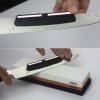What Jason said makes a lot of sense to me, basically because I’ve believed the same for a long time. I would also observe that nowadays he can’t say “I have a sharp knife” without hurting somebody’s feelings. I think he does the right thing by calling it as he sees it, and not appeasing the feelings of the irrational among us.
So I think we’ve established that some guided systems can produce more even (i.e. matching each other) bevels than many people can hold freehand. The question is, does that matter? Before you say, “Of course it does, you moron!” (don’t worry about hurting my feelings, I left them behind me long ago), kindly consider the chisel and plane iron blades. Sufficiently sharp to cut a wood shaving you can read a newspaper through (a fun Neanderthal trick), they have only one bevel. The other side is flat, or within a few thousandths.
So each individual must decide for themselves the importance of “even” bevels for each steel/heat treat/geometry. If this particular knife needs them, set up the guided system. If not, down the freehand road I go.
Just like Ford vs Chevy, Colt vs Smith, Cheerios vs corn flakes, this is a question that can produce volumes of discussion without a clear winner.
To the OP: there is no universal “better”, there’s just “better for you” - considering your own situation and preferences. Fast or slow, cheap or expensive, high tech or old school, all choices YOU will make on the path to getting and keeping YOUR knife sharp. Not exclusive choices either, you can mix and match a wide range of abrasives with no penalty. You can switch back and forth between methods any time you choose.
My path to sharp, or Jason’s or Garry’s, might not be the best for you. We’ll all probably continue refining our own best practices until the day we can no longer lift knife, and then somebody else will take up our gear and knives, and the whole process will start over for them while we’re being fed applesauce with a spoon. It’s all circular.
Parker

